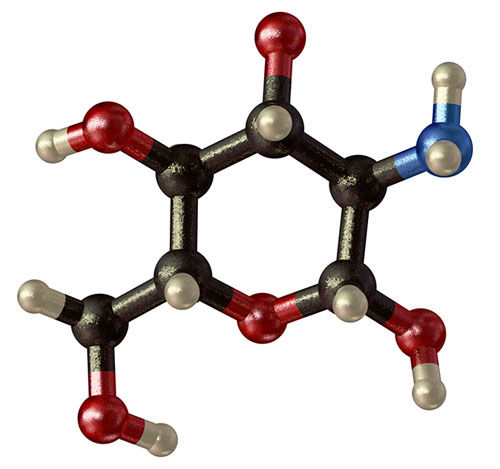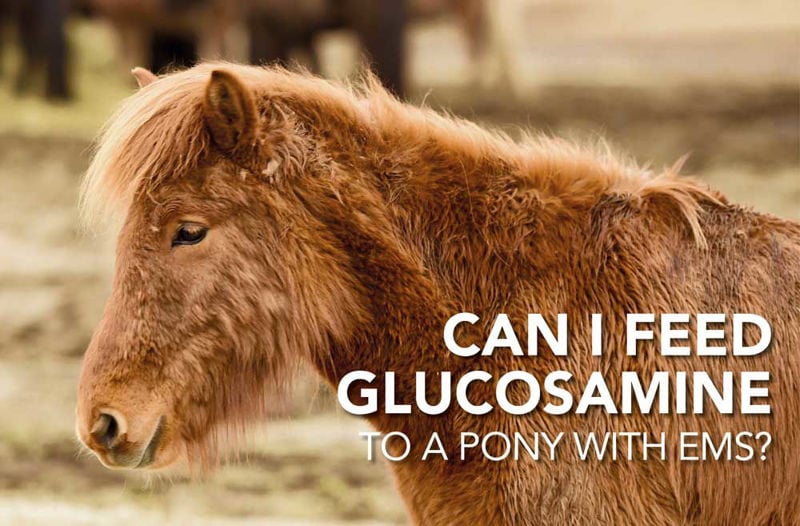A question we get asked a lot by customers is whether it is safe to feed glucosamine to horses and ponies with conditions such as Equine Metabolic Syndrome and Insulin Resistance. There is concern that, because glucosamine is principally glucose with an amino group, it could enter glucose pathways in the body and influence insulin sensitivity and glucose uptake into cells.
Research has shown that only 1% of the Glucosamine, when supplemented orally, is converted to Glucose and this would only raise blood glucose levels by 0.06mmol/l, which is essentially unmeasurable (Anderson et al, 2005). Interference with glucose metabolism occurs only at concentrations within the 2– 50 mmol/L range, and these concentrations that are several hundred- to a thousand-fold greater than plasma concentrations that occur during oral supplement use (Simon et al, 2011).

Glucosamine structure
Oral administration of large doses of glucosamine in animals has no documented effects on glucose metabolism. Studies on animals that have shown an effect on glucose metabolism have used levels of glucosamine 100 – 200 times higher than what would be provided in an oral supplement, which was also administered intravenously (Rossetti et al. 1995; Patti et al. 1999; McNamara et al. 1996; Stender and Astrup, 1977).
In contrast there are many human studies that have found that oral supplementation with the recommended daily amount of glucosamine, or even with high levels of oral supplementation, has no effect on blood glucose levels or insulin sensitivity, both in healthy people and those with Type 1 and Type 2 diabetes (Tapadinhas et al. 1982; Scroggie et al. 2003; Yu et al. 2003; Tannis et al. 2004; Albert et al. 2007; Hirayama et al. 2007)
In conclusion horses are unlikely to absorb enough orally administered glucosamine to reach sufficiently high blood concentrations to interfere with glucose metabolism or induce insulin resistance. In addition, many studies on animals and humans has shown that oral administration of glucosamine has no adverse effect on insulin sensitivity or blood glucose levels. Based on this, Glucosamine is a very safe ingredient to feed to horses and ponies with metabolic issues such as EMS and IR and will have no adverse effect on their sugar levels or the Metabolic Issues that they have.
For any advice or questions you may have, please don't hestiate to reach out to our expert nutrition team. You can call 0800 585525 Monday-Friday 8:30am-5:00pm. Email [email protected], or send us a DM on social media.
References
- Albert S.G., Oiknine R.F., Parseghian S.,Mooradian A.D., Haas M.J. and McPherson T. (2007) ‘The effect of glucosamine on serum HDL cholesterol and apolipoprotein AI levels in people with diabetes.’, Diabetes Care, 30, pages 2800– 2803
- Anderson J.W., Nicolosi R.J. and Borzelleca J.F. (2005) ‘Glucosamine effects in humans: a review of effects on glucose metabolism, side effects, safety considerations and efficacy.’ Food and Chemical Toxicology, 43(2), pages 187-201
- Hirayama B.A., Loo D.D. and D´ıez-Sampedro, A (2007) ‘Sodium-dependent reorganization of the sugar-binding site of SGLT1.’, Biochemistry, 46, pages 13391– 1406
- McNamara P.S., Barr S.C. and Erb H.N. (1996) ‘Hematologic, hemostatic, and biochemical effects in dogs receiving an oral chondroprotective agent for thirty days.’ AmJVetRes, 57, pages 1390– 1394
- Patti M.E., Virkamaki A., Landaker E.J., Kahn C.R. and Yki-Jarvinen H. (1999) ‘Activation of the hexosamine pathway by Glucosamine and Diabetes 27glucosamine in vivo induces insulin resistance of early post receptor insulin signaling events in skeletal muscle.’, Diabetes, 48, pages 1562– 1571
- Rossetti L., Hawkins M., Chen W., Gindi J. and Barzilai N. (1995) ‘In vivo glucosamine infusion induces insulin resistance in nor moglycemic but not in hyperglycemic conscious rats.’ Journal of Clinical Investigation, 96, page 132
- Scroggie D.A, Albright A. and Harris M.D. ‘The effect of glucosamine-chondroitin supplementation on glycosylated hemoglobin levels in patients with type 2 diabetes mellitus: a placebo-controlled, double-blinded, randomized clinical trial.’, Arch Intern Med, 163, pages 1587– 1590
- Simon, R., Marks, V., Leeds, A. and Anderson, J. (2011). ‘A comprehensive review of oral glucosamine use and effects on glucose metabolism in normal and diabetic individuals.’, Diabetes/metabolism research and reviews, 27, pages 14-27.
- Stender S. and Astrup P. (1977) ‘Glucosamine and experimental atherosclerosis. Increased wet weight and charged composition of cholesterol fatty acids in aorta of rabbits fed a cholesterol-enriched diet with added glucosamine.’, Atherosclerosis, 26, pages 205– 21
- Tannis A.J., Barban J. and Conquer J.A. (2004) ‘Effect of glucosamine supplementation on fasting and non-fasting plasma glucose and serum insulin concentrations in healthy individuals.’, Osteoarthritis Cartilage, 12, pages 506– 511
- Tapadinhas M.J, Rivera I.C. and Bignamini A.A. (1982) ‘Oral glucosamine sulphate in the management of arthrosis: report on a multi-centre open investigation in Portugal.’, Pharmatherapeutica, 3, pages 157– 168
- Yu J.G., Boies S.M. and Olefsky J.M. (20036) ‘The effect of oral glucosamine sulfate on insulin sensitivity in human subjects.’, Diabetes Care, 26, pages 1941– 1942.



